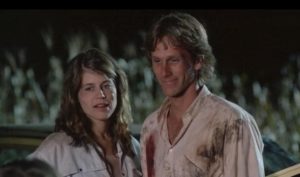With films like “The Shining” and “The Green Mile,” many of Stephen King’s blockbuster novels have been turned into hit motion pictures. Unfortunately, the 1984 film “Children of the Corn” is not one of them. The movie had such promise: a town run amok by killer kids branding all manner of weapons, the ghost town mentality; heck, even the movie’s poster featured an eerie blood red cover with a menacing scythe stretching overhead. Regrettably, the film makes one too many errors, over-explains all its horror, and, uncommon a complaint from this writer, has too low a body count to make any kind of an impact.
The film’s opening is brutal and frightening; so brutal, in fact, that the let down that is the rest of the film comes as a surprise. Without giving away specifics, suffice it to say that most of the adults are now removed from the town, children rule it all, at the helm one elder boy named Malachai (Courtney Gains, of Rob Zombie’s “Halloween” fame) and a younger, cultish-type boy named Issac (John Franklin). The basic plot here is that they all belong to some strange religious cult and must offer “sacrifices” to appease whomever “it” is.
In the midst of this a typical American couple, Burt and Vicky (Peter Horton and a young Linda Hamilton) are making their way cross country, but can’t seem to get away from the region’s eerie town, Gatlin, and end up intertwined in the movie’s bizarre proceedings.
First the positives. Cinematically, the film is well done, delivering both an authentic ‘80s atmosphere, and making the region’s cornfields somehow much creepier than they should be. Certainly the best examples of this are when one boy is stalked through the fields by an unknown assailant; worse yet when Burt and Vicky find his mutilated body on the road. They initially think they’ve run him over; but it soon becomes apparent that something much more foul is afoot.

There’s also the town of Gatlin itself, devoid of all life, run-down building and once prospering businesses that now law defunct the only scenery. The couple runs across a pair of children who are apparently not in on the killing but are weird nonetheless. The girl, oddly quiet, is prescient, and draws eerie pictures in crayon of what will happen. She depicts murders and sacrifices, and adds to “Children of the Corn” in effective ways.
Regrettably, that’s about all the movie has going for it. The score and setting are good, but the basic problem is that Director Fritz Kiersch shows way too much behind the scenes, and explains away all the events that had the potential to be scary.
First there’s the body count, which is virtually nonexistent after the film’s grisly opening. Modern films like “The Hitcher” or “The Texas Chainsaw Massacre” irk me for the reason that they show not antagonists stalking victims to build suspense, but only gratuitous gore. But here, the stalking is drawn out to a patience-losing degree, and the payoffs are never worth the wait. It also doesn’t help that most of the suspense-building parts of the movie take place in broad daylight, taking away the horrors a cornfield at night would have to offer.
Second, any fright that the sea of cornfields had to offer – especially what horrors may lay inside – are stripped from the movie as Kiersch shows scene after scene of the various Children of the Corn huddled in a circle, chanting, praying, discussing their next sacrifice, discussing what to do with Burt and Vicky, the two ‘interlopers.’ It’s as if the filmmakers abandoned all sense of leaving events up to the imagination and just decided to tell audiences exactly what to expect. There’s even some half hearted attempts by Burt to comment on the fallacy of believing in false religion, but its for not. Children, small in stature, would have been better served here silently stalking and dispatching their victims, not painted in broad daylight as a force to be reckoned with.
– by Mark Ziobro